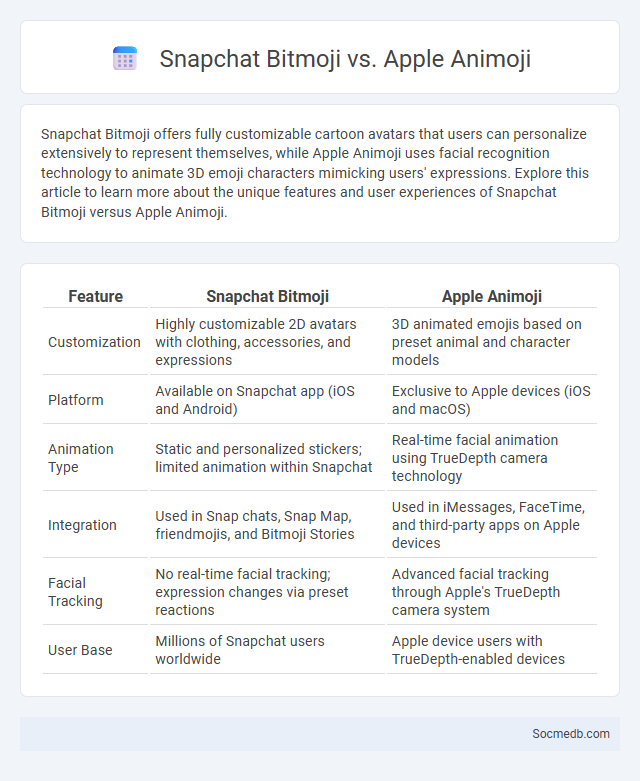
Photo illustration: Snapchat Bitmoji vs Apple Animoji
Snapchat Bitmoji offers fully customizable cartoon avatars that users can personalize extensively to represent themselves, while Apple Animoji uses facial recognition technology to animate 3D emoji characters mimicking users' expressions. Explore this article to learn more about the unique features and user experiences of Snapchat Bitmoji versus Apple Animoji.
Table of Comparison
| Feature | Snapchat Bitmoji | Apple Animoji |
|---|---|---|
| Customization | Highly customizable 2D avatars with clothing, accessories, and expressions | 3D animated emojis based on preset animal and character models |
| Platform | Available on Snapchat app (iOS and Android) | Exclusive to Apple devices (iOS and macOS) |
| Animation Type | Static and personalized stickers; limited animation within Snapchat | Real-time facial animation using TrueDepth camera technology |
| Integration | Used in Snap chats, Snap Map, friendmojis, and Bitmoji Stories | Used in iMessages, FaceTime, and third-party apps on Apple devices |
| Facial Tracking | No real-time facial tracking; expression changes via preset reactions | Advanced facial tracking through Apple's TrueDepth camera system |
| User Base | Millions of Snapchat users worldwide | Apple device users with TrueDepth-enabled devices |
Introduction: Exploring Digital Avatars
Digital avatars serve as personalized representations in social media, allowing you to express identity through customizable visuals and interactive features. These virtual personas enhance engagement by bridging the gap between real-world presence and online interaction. Tailoring avatars to reflect personality, interests, and moods fosters deeper connections within digital communities and strengthens social networking experiences.
What is Snapchat Bitmoji?
Snapchat Bitmoji is a personalized avatar feature integrated within the Snapchat app, allowing users to create cartoon-like representations of themselves. It enhances user interaction by enabling the customization of facial features, hairstyles, and outfits, which can be used in chats, snaps, and stories. Bitmojis are linked to the Snapchat profile, making the social experience more engaging and unique.
What is Apple Animoji?
Apple Animoji are animated emojis that leverage the TrueDepth camera system on iPhone models with Face ID to create personalized, expressive characters that mimic your facial movements in real-time. These Animoji can be used in Messages and FaceTime, allowing you to send customized video messages or stickers that capture your voice and expressions for a more engaging social media experience. Your interactions become more dynamic by integrating these unique digital avatars into chats and posts, enhancing communication with a playful, high-tech twist.
Bitmoji Overview: Features and Functionality
Bitmoji offers personalized avatars that users can customize with various facial features, outfits, and accessories to create expressive digital characters. The platform integrates seamlessly with Snapchat, enabling users to send Bitmoji stickers in chats, stories, and snaps for enhanced communication. Key features include a vast library of customizable emotions and actions, making Bitmoji a versatile tool for social media interaction and self-expression.
Customization: Bitmoji vs Animoji
Customization options of Bitmoji offer extensive personalization of avatars, allowing users to tailor facial features, hairstyles, and outfits to reflect their unique identity. Animoji, by contrast, use facial recognition technology to animate preset emojis with your expressions, providing a dynamic but less customizable user experience. You can enhance your social media presence more effectively with Bitmoji's broader design flexibility compared to Animoji's limited avatar choices.
Integration with Social Platforms
Seamless integration with social platforms like Facebook, Instagram, Twitter, and LinkedIn enhances your brand visibility and streamlines content sharing across multiple channels. Leveraging APIs and social media management tools allows for automated posting, real-time analytics, and targeted audience engagement. Optimizing this integration drives higher user interaction and maximizes your marketing ROI.
Animation Capabilities Compared
Animation capabilities on social media platforms vary significantly, with Instagram and TikTok offering advanced tools for creating dynamic, engaging short-form videos while Facebook and Twitter provide more basic animation features for posts and ads. TikTok's extensive library of effects and transitions allows users to craft highly polished animations that capture audience attention, enhancing Your content's visual appeal and interactivity. Understanding these differences helps optimize your social media strategy by leveraging the best animation tools for each platform's unique user engagement style.
User Experience and Accessibility
Social media platforms prioritize user experience by implementing intuitive interfaces and personalized content algorithms that enhance engagement and ease of navigation. Accessibility features such as screen reader compatibility, customizable text sizes, and keyboard shortcuts ensure inclusive interaction for users with disabilities. Continuous testing and updates based on user feedback optimize platform usability and broaden access for diverse audiences.
Privacy and Security Concerns
Social media platforms collect extensive personal data, raising significant privacy and security concerns for users worldwide. Unauthorized access, data breaches, and misuse of information can lead to identity theft, cyberstalking, and financial fraud. Implementing strong encryption, multi-factor authentication, and regular privacy audits is essential to protect sensitive user information.
Which Avatar App is Best for You?
Choosing the best avatar app depends on your specific needs such as customization options, platform compatibility, and animation features. Popular apps like Bitmoji offer extensive personalization and social media integration, while ZEPETO provides 3D avatars with interactive environments suitable for gaming and social engagement. For professional or business use, apps like Ready Player Me allow cross-platform avatars compatible with VR and metaverse applications.
 socmedb.com
socmedb.com